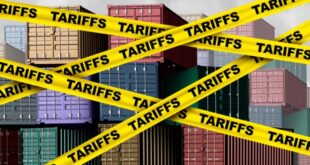The Trump Administration’s China tariff’s are the closest thing to a cloud on the horizon for a market that stayed red hot during all of 2018. More construction is expected and vacancy should stay low, according to several brokers.
Can the Inland Empire industrial market stay as strong in 2019 as it was this year, or maybe improve its performance?
In a word, yes, according to several brokers and one analyst, all of whom are intimately familiar with the logistics market in Riverside and San Bernardino counties.
“There are so many businesses coming into [the Inland Empire] that the industrial market can’t help but stay strong,” said Jerry Holdner, research director for Kidder Mathews, a west coast commercial real estate firm. “Vacancy is below five percent, which is about as low as it can go, and absorption is up. That’s a strong market.”
Industrial vacancy in the two-county region will remain at or below five percent next year, and construction should equal or outperform the last several years, Holdner predicted.
The Inland Empire has been the strongest industrial market in the United States for several years, and its recent performance shows no sign of a downturn.
During the third quarter of this year, the industrial lease rates in the two-county region averaged 59 cents per square foot, a rise of six cents compared with the third quarter of 2017, according Voit Real Estate Services.
Vacancy was 4.3 percent, down from 6.07 year-over-year. The west end – Ontario, Rancho Cucamonga and Corona – was almost full, with a vacancy rate of 2.3 percent.
Also during the third quarter, the most recent data available, a little more than five percent of the region’s logistics space was on the market, either for sale or sublease.
That number is expected to inch up during the next year or so, as more speculative projects are built and imports moving through the Los Angeles and Long Beach ports increases, as they’re expected to, Voit predicted.
“The strong demand for warehouse and distribution centers in the Inland Empire, despite rising construction costs and healthy rental rates, is justifying the continued development of industrial properties,” Voit’s third quarter report stated.
At the end of the third quarter, there were 89 industrial buildings under construction in the two-county region that combined will cover approximately 22 million square feet. Those projects include the Optimus Logistics Center in Perris, a two-building industrial park that will cover 1.4 million square feet, and the Ontario Ranch Logistics Center in Ontario, a 1.1 million square-foot development, according to Voit.
Data, client feedback and market research all indicate that 2019 will be a strong year for the Inland Empire’s industrial market, said Ian Britton, managing director for CBRE Ontario.
Demand for more warehouse space is expected to continue, driven mostly by the growth of e-commerce, Britton said in an email.
“Our [data] suggests that there could be approximately four million to five million square feet of new lease transactions complete over the next 45 to 60 days, which would be approximately 10 transactions,” Britton stated. “That would be a great way to finish 2018 and kickoff 2019.”
Total industrial activity in the Inland Empire was up seven percent year-over-year in the third quarter, while rents grew an average of six percent during that time. By the end of 2018, the market will top 40 million square feet of gross activity for the fourth consecutive year, according to CBRE.
Looking ahead to 2019, CBRE predicts that approximately 25 million square feet of industrial space will be built in the Inland region, which would likely be the most industrial construction of any market in the nation.
Demand for industrial space will remain stable next year even though there is more land available on the east end. Construction and rent growth will remain strongest on projects below 250,000 square feet and above 600,000 square feet.
Because it relies so heavily on imports, the Inland industrial market could be threatened by the Trump Administration’s tariffs on China, which accounts for many of the goods that come into the region.
“The tariffs have had little impact so far,” Britton wrote. “Should trade disputes escalate, it could negatively impact industrial demand in our region.”
Holdner agreed, saying he expects Trump’s actions to produce results in the long run.
“He’s shaking things up and I think that’s good,” Holdner said. “He’s right that their tariffs need to go down and ours need to go up.”
The ports remain active and retail is strong, so there’s no reason to believe 2019 won’t be a good year for the Inland Empire’s industrial sector, said Cody Lerner, senior associate with Avison Young and an industrial specialist.
“We expect to see real growth as long as interest rates remain relatively stable,” Lerner said. “Construction might slow a little bit, but there are still a lot of [investors] looking to get into the Inland market. It should be a strong year.”
 IE Business Daily Business news for the Inland Empire.
IE Business Daily Business news for the Inland Empire.

